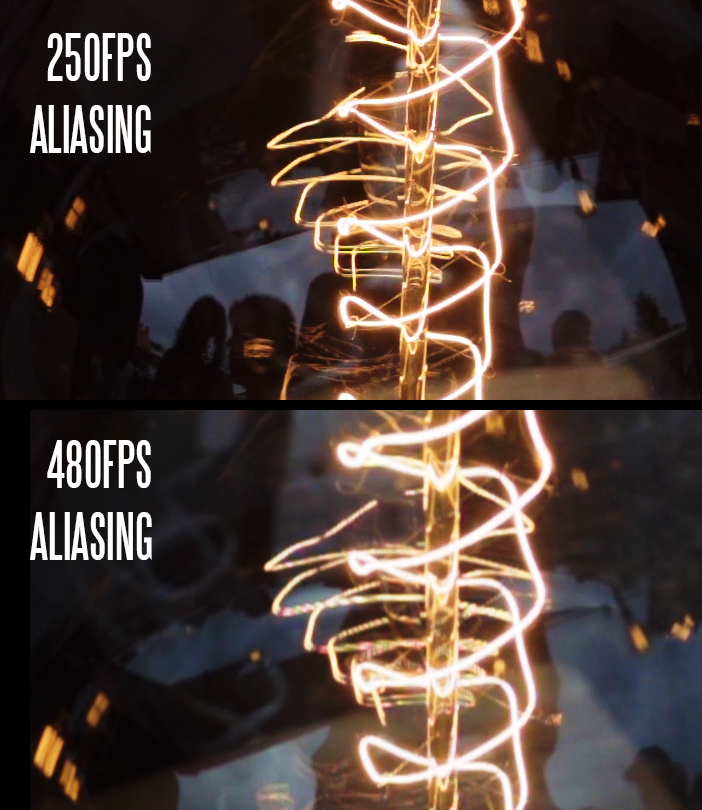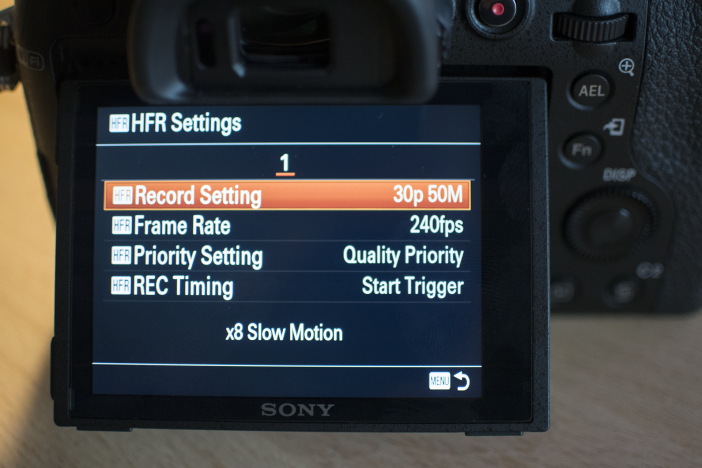The slow-mo capabilities of the new Sony RX cameras are groundbreaking.
I’ve been shooting at 100fps to 1000fps and everything in between.
Here is everything you need to know.
100fps and 120fps
Sony were the first to introduce 1080/60p several years ago on the NEX 7. Now they are the first to do proper 1080/120p. I say proper because this is an insane image you are getting – equal to 24p and as sharply detailed as the Canon C300 or Sony A7S. The pixel binned 1080/120p of the Samsung NX1 or the GH4’s 96fps mode do not come close for quality. There’s no moire and aliasing.
The below video shows the full gamut of quality from 120fps to 960fps. No sharpening in post has been applied and detail is dialled all the way down in the S-LOG profile in-camera.
https://vimeo.com/134003377
As you can see the 250fps is actually VERY good as well!
However the camera has a focus bug in the HFR modes (240fps to 960fps) which I’ll come to in a moment.
Thankfully 120fps (100fps in PAL) is a regular movie recording mode not a separate mode and you can check focus during a shot, record continuously and toggle recording while in stills mode.
The XAVC-S bitrate of 100Mbit/s is again very impressive and double that of the A7S or the higher frame rate modes which are 50Mbit/s. That bitrate though is quickly gobbled up by such a large number of frames. There are some compression artefacts like macro blocking in the sky but hardly noticeable.
The great thing about 120fps is you can do a very quick AF lock onto a moving subject then hit record straight away. You can’t do this in the HFR modes. For run and gun, 120fps is the answer.
240fps and 250fps
240fps and onwards are accessed in a dedicated HFR mode on the camera’s mode dial.
At 240fps as I said above, image quality is SUPER.
However the HFR mode brings with it some poor design decisions and even a serious firmware bug in the case of the RX10 II. I have reported the problem to Sony’s team.
Image quality at 250fps is truly excellent and shooting with it great fun. In HFR mode the RX100 IV and RX10 II run frames off the sensor at an insane rate into a high speed memory buffer chained directly to the CMOS. The camera isn’t capable of outputting the higher frame rates directly to the card because it must debayer the raw data first and encode to H.264 (XAVC-S). After capturing your 2 seconds of movement at 240fps, you must wait around 10 seconds for it conform this to the card at the frame rate you selected in the HFR menu (24,30,50 or 60p). When recording is done, you can then proceed to shoot the next shot.
This is similar to the way high frame rates are handled on the Sony FS7.
The problem with the way it is done on the new RX cameras though is that the standby mode is poorly implemented.
Before pressing record in HFR mode you have to press the middle d-pad key to prime the camera ready to go. Once in this standby mode you cannot adjust focus, change exposure or reframe using the zoom – the camera basically shuts down. Unfortunately if you accidentally brush the zoom rocker switch or the manual focus ring a bubble pops up on the screen obscuring your shot at a critical moment and needs a further key press to dismiss. The “Invalid Operation” prompt is really unnecessary.
With a controlled subject and set, you can afford to work slower to nail focus and exposure manually in HFR mode. It does offer 100% manual control over the capture. However in a run & gun situation, it is necessary to use AF to target your subject and then very quickly before your subject goes out of focus or out of the frame, hit record. In HFR mode the AF too often drifts to the background even if your subject is bang centre and taking up most of the frame. The AF is much slower to get a lock in this mode than it is in stills mode and you can’t half press the shutter release to confirm focus, nor is there a green AF box that lights up when focus has been achieved on the centre point.
So by the time you have waited for the focus system to get its act together, pressed the standby button and finally the record button, very often your shot has changed and you need to back out of standby mode, re-focus, re-frame and try again. This is very frustrating.
HFR focus bug
https://vimeo.com/134010097
In all the HFR modes I have a focus problem on my RX10 II in both manual focus mode and AF mode.
It is particularly noticeable at the long end of the zoom (200mm) wide open at F2.8.
Often the focus will shift when you enter HFR standby mode before hitting record, then when you exit standby the focus is back to where you put it.
Sometimes the camera will get so confused that the shot is totally blurry when you enter standby and totally sharp when you exit. The upshot is that your HFR recording is going to be out of focus.
I had to scrap quite a lot of the review material and test shots for this reason and I hope Sony inspect this and issue a prompt firmware fix for it.
I did test a second RX10 II body and confirmed that both cameras had the same bug.
I was not able to reproduce the problem on the RX100 IV which has a different lens and lacks the 200mm long end or close focussing abilities in telephoto.
At first I thought it was a result of a softer image in 240fps compared to the regular live-view mode or movie mode. However on a shot where I had focussed on a subject close to infinity (but not quite at infinity) I noticed the focus had shifted because the background was sharper than in non-standby mode, ditto on the final recording. I then placed lights so that the frame had a pronounced bokeh and indeed the focus shift was evident from the bokeh changing in size.
What is strange is that it doesn’t always occur and sometimes it is worse than at other times!
480fps to 500fps
https://vimeo.com/134004930
The 480fps (NTSC) and 500fps (PAL) mode can be beautiful.
However image quality is a significant step down from 250fps with heavy moire and aliasing. It is much softer and is upscaled from a much lower resolution to the 1080p container file.
960fps to 1000fps
At this rate most regular real life subjects resemble a still which looks slightly animated. You’re better off shooting at 480fps and applying Twixtor at 50%. Things do start to get interesting however when you meet a super fast moving subject… providing you can keep it in focus!
What I like about 480fps is that a lot of the real-world looks poetic, like rain drops falling slowly down the frame from top to bottom or a girl’s hair waving gently in the breeze even if in reality a mad gale is blowing. 960fps is more of a speciality thing really… something for a science lab or pyrotechnics. Often even 240fps is plenty enough!
In this mode image quality is ultra pixilated and soft with very heavy moire but this is 100% expected.
Conclusion
The rapid fire rates of HFR mode on the new Sony RX camera are great but their speed isn’t matched by the slow implementation. I can’t see a good reason why one shouldn’t be able to shoot HFR video clips at 240fps+ with the speed and responsiveness of the RX10 M2’s stills mode. This means super fast AF to quickly establish focus on a moving subject, focusing and zooming right up to the moment you hit record, one button to record and an instantaneous capture of 240fps video.
There are too many pop-up messages in the user interface, we don’t keep needing to be told that an operation is “Invalid” and we especially don’t want to have to press a button to dismiss the message. It delays us at that critical moment when we are about to finalise the shot for the last time and hit record.
The long ‘recording’ times after buffering from the sensor to RAM are something to consider as is the short burst times for HFR of around 2 seconds in the quality priority mode compared to very high quality 120fps which is continuous. By far my favourite way to capture slow-mo on the Sony RX100 Mk IV and RX10 Mk II is the regular 1080/120fps mode. It is the first recording mode circa-100fps I have used that doesn’t resort to heavy pixel binning on the sensor like with Sony A7S, Samsung NX1 and Panasonic GH4. The image is flawless, detailed and sharp. You can work in stills mode for faster one-shot AF to establish focus on a quickly moving subject for instance.





